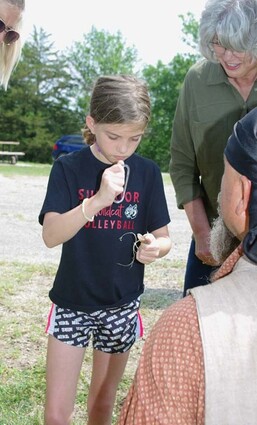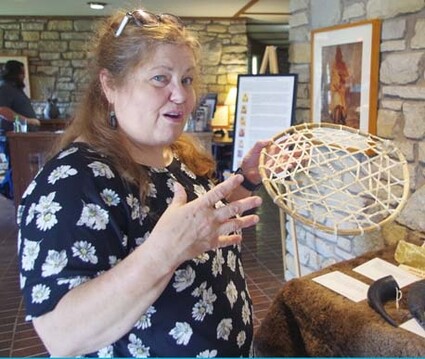Mountain Men demonstrate fur tradersʼ skills
June 8, 2023

Charlotte Coffey turned 9 years-old this week. Saturday, because of her attentiveness at the mountain man rendezvous she was presented with two gifts. The first was a white hole bead. It was threaded onto piece of sinew and tied to her left wrest. The second was a fire starting kit. Above, she attempts to strike a spark with a piece of flint and an iron striker. Charotte's mother, Haley, works at the Family Medical Center, Superior.
A steady stream of people, many of them children,visited with mountain men at a rendezvous at the Pawnee Indian Museum near Republic, Saturday. Six mountain men had arrived Friday evening and camped overnight near the mound, practicing their survival skills and imaging what it was like for the Indians to live there.
Saturday, a steady flow of people chatted with them about the fur trading era in the U.S. from 1800s to 1849, when China captured the world's fur trade with the silk worm. They talked of the tools needed for survival, how to trap a beaver, demonstrated how to start a fire using a small piece of flint and an iron striker, talked about muzzle loaders and how to keep gun powder dry and answered a host of questions. Each mountain man was dressed in perior costume and easily talked about various aspects of the time period.
There was a beaver trapping display under one canvas lean to. Each beaver has its own scent. They gather small pieces of wood with bark intact and store it underwater for winter food. Their continuous knawing keep thier teeth sharp. The knawing also is important to the beaver's existance as it keeps their rapidly growing teeth ground down so they can chew. A beaver pelt was passed so participants could see the soft underfur and the long hair. The underfur keeps the beaver warm much like the wetsuit so it can survive and swim in the cold of winter and the long hair helps it glide through the water.
During the first half of the 80th century, blankets were marked with strips of beaver pelt. Commonly the best blankets (both thicker and bigger) were marked with four strips and used only by the wealthy. Blankets with one or two strips were generally about twin size and generally used by mountain men. A two strip blanket costs two beaver pelts. Today one can purchase similar blankets from the Hudson Bay Company. A four strip blanket costs roughly $250 dollars. They also now make six and eight strip blankets which will fit queen and king size beds.
Most of the blankets made in the 1800s were earth tones as they were the easiest to dye. Green was more rare as it has to be dyed twice which increase the cost.
When the fur trade died, many mountain men ,like Kit Carson, became scouts for the army. They already were familar with the territory and knew local Indians, so they could advise the military about Indian customs.

Being able to start a fire and travel light were essential skills for a mountain man's survival. Saturday, they demonstrated rapidly starting a fire with char cloth, flint and an iron striker. Punk wood was often used in place of char cloth. A member of the audience said, "Dryer lint works well."
Small pine slivers burn slowly and make good "matches." Jute twine split into small strands also easily pick up a spark. Another also demonstrated starting a fire green with green pine bark nearly rubbed into powder and a piece of glass.
Another compared starting a fire with parts of a human body. He said, "After you get a fire started, you add small pieces - smaller than your pinky, then the size of a finger, a bit bigger than your finger, then wood the size of your wrist and a long as your arm and finally pieces as big around and as long as your leg.
Mountain men still gather and compete using various survival skills which would have been needed in the 1800s. Competition generally includes fire starting. At the last competition one of the mountain men attended, all of the fire starting supplies were dropped into a bucket of water. The mountain man who started a fire first won the competion. Early Saturday morning was a tough time to start a fire as the humidity was high in the Republic area.
Everything a mountain man owned had to be easy to pack and carry. For one, a flat four-inch diameter can carried his sewing kit and fishing gear. It included sinew (back strap from a deer) for his thread and fishing line, small fish hooks, a large needle with which he could patch his leather clothing and some dried rawhide. The rawhide was used to patch clothing.
Sinew was used by the Indian on their bows. They never left a bow strung as sinew will stretch with moisture.
Velvet leaf, a common plant in the area, can also be used to make rope. The yuca plant will also make excellent coradage.
Another small can often carried by the mountian men held items for trade. When they delivered the furr pelts to market, they could trade for beads and other small items the Indians liked. Different parts of what we now know as the United States where under the control of various European Countries: England, France and Spain. Towns on the borders of the different regions generally were trading posts where pelts could be delivered and traded like money for goods. Saturday one mountain man's small trading can contained trade times from England: white heart blue beads (about half the size of the end of a woman's smallest finger) and African Blues ( a bit larger bead that was dark blue.)

Only a few places on the plains had good flint: some in Texas, Iowa, Oklahoma and Wyoming. Indians who lived close by used the high quality flint for trading.
Museum featured Bison Trunk
Betty Bouray, Pawnee Museum curator, was delighted with the day's activities. "There has just been a steady flow of people through the museum this morning," she said.
Area newspapers had reported it was the last week for the "Bison Truck" - which was suppose to read "Bison Trunk". The trunk was positioned just inside the museum's front entrance and was a display of items made by tribal Indians using bison. Items included a bison bladder - used to carry water, a netted hoop - used by children as a toy and to practice target shooting with their bows; polished horns - used as a cup or shaped into a spoon or a musical instrument; tans hides with hair - made into mittens with the hair on the inside and many other items.
"Admission is free this year," Bouray said. "We are working under a new slogan, "No barriers! Everybody should be able to see Kansas history."
"I started 22 years ago and it was free then," she smiled.

Betty Bouray, curator of the Pawnee Indian Museum near Republic, holds a hoop used by children to play games. It was part of the Bison Trunk on display this past month at the museum entrance.
"The bison trunk has been really popular.," she continued. "The state has other trunks available for loan, so I plan to bring some more trunks to the museum."





Reader Comments(0)